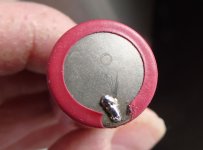royfellows
Well-known member
I have recently been charged with the task of upgrading and overhauling a batch of my original WorkStar Oldham conversions. These lamps were an LED conversion of Oldham pit lamps to 2 single mode outputs of modest power, lamp using original cable into a sealed ABS case with aluminium belt bracket. The case contains 2 parallel 18650 cells with electronic short circuit - over discharge- overcharge protection and potted in with silicone. Charging was by Li Ion rack charger. The example with the battery pack shown in the picture has been in use for at least 10 years. The Li Ion cells were Chinese Trustfire 2500 mAh because high quality cells were very expensive in those days. Please note I now only use quality genuine Sanyo cells, recommended UK supplier is FogStar, I use them.

Anyway, the lamp in question had been very heavily used and the case was broken quite badly and obvious. The potting had failed to protect the cells, probably through gap or whatever, and water ingress to the cells had happened. Now regardless of the heavy corrosion the lamp was still giving 8 hours of USABLE light at a draw of 350 mA (7135 linear chip). We can therfore say that its 4 hours per cell at 350 mA which indicates 1400 mAh remaining capacity. Now the cells were only originally rated at 2500 mAh, so bit of an eye opener.
This also answers questions about water coming into contact with cells.
I just had to post about this. Now note that waht appears to be a vent in the top of a cell is not that. Its an anti explosion valve, the cells do not need to breath, but in extreme cases can suffer from what is known as "thermal runaway", the valve is there to prevent pressure building up inside the cell leading to an explosion.
Anyway, the lamp in question had been very heavily used and the case was broken quite badly and obvious. The potting had failed to protect the cells, probably through gap or whatever, and water ingress to the cells had happened. Now regardless of the heavy corrosion the lamp was still giving 8 hours of USABLE light at a draw of 350 mA (7135 linear chip). We can therfore say that its 4 hours per cell at 350 mA which indicates 1400 mAh remaining capacity. Now the cells were only originally rated at 2500 mAh, so bit of an eye opener.
This also answers questions about water coming into contact with cells.
I just had to post about this. Now note that waht appears to be a vent in the top of a cell is not that. Its an anti explosion valve, the cells do not need to breath, but in extreme cases can suffer from what is known as "thermal runaway", the valve is there to prevent pressure building up inside the cell leading to an explosion.




